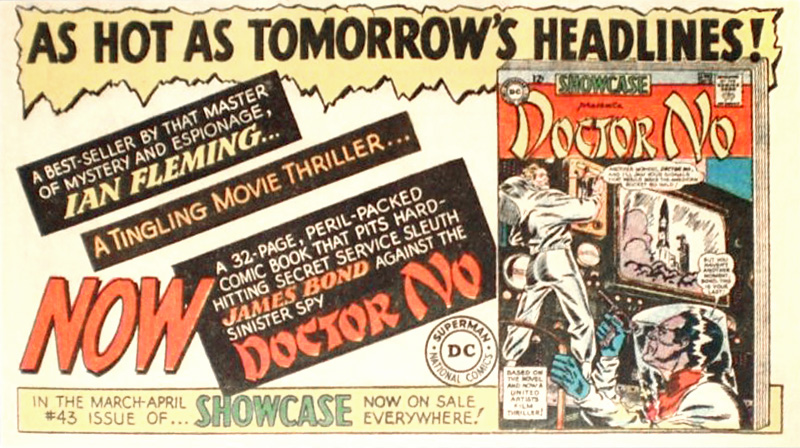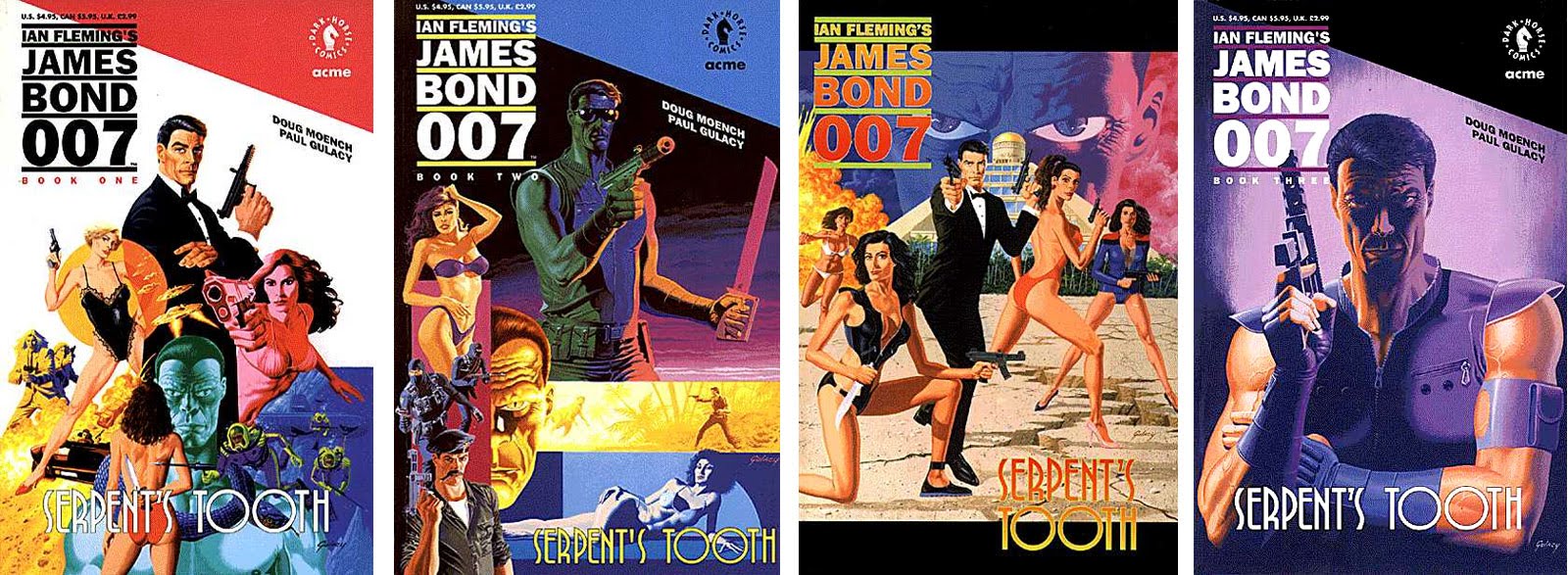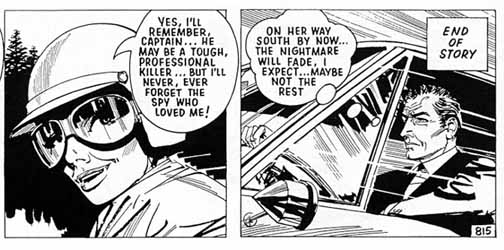 |
 |
COMIC BOND
In the pages of comics and graphic novels, James Bond has battled supervillains and encountered global threats that come dangerously close to violating Cubby Broccoli's edict, "Bond may go wildly beyond the probable, but not the possible." But it wasn't always so. During the 1950's, Fleming took an active interest in the writing and accuracy of the work that was adapted from his books. Fleming closely supervised the artwork for the covers of his books, and similarly oversaw the creation of the illustrated Bond -- hiring an artist to sketch Fleming's vision of Bond, so that the comic strip illustrator would have an idea of how his creation should look. The results were very successful, and quite popular. 
 Artist Yaroslav Horak went on to draw the strip during the 1970's, to stories written by Jim Lawrence. The strips did not solely appear in the Daily Express, but were featured in other UK newspapers as well as publications abroad. When the Fleming titles ran out, they even adapted the first continuation novel by Kingsley Amis, entitled Colonel Sun:  The series then continued intermittently with original stories, lasting until the 1980s. The Daily Star concluded Bond's UK newspaper run with Polestar, and by 1983, 45 adventures had been syndicated in British newspapers, with an additional 7 adventures published abroad. An amazing 6,500+ strips had been produced over the 25 year period. Notable Bondian titles were; Die With Your Boots On, The Nevsky Nude, and Polestar. As you can see, below, as the series went on, the content got a lot racier -- especially for a syndicated newspaper comic strip:  
Takao Saito's 007 (1964-1967): In 1964 the famous Japanese artist Takao Saito produced four very loose adaptations of the Fleming novels Thunderball, The Man With The Golden Gun, OHMSS, and Live And Let Die. The stories were serialized in a monthly comic book, and then later collected. Even though they were officially licensed, Glidrose put an abrupt stop to the series in 1967. Zig Zag Series (1968-1970): In 1968 Chilean publisher Zig Zag published original James Bond adventures in comic book format. The Zig Zag Bond was clearly based on Sean Connery. In 1970 the comic had to cease publication when the political climate of Chile was transformed by the election of a new Marxist government. Semic Press Series (1981-1996): Originally Semic Press in Scandinavia reprinted the Daily Express strips in their comic book entitled James Bond. Then, in 1981, Semic started publishing their own original stories with titles such as Operation: UFO, Experiment Z, and Kill Bond! The comic ran until 1996. After Ian Fleming's widow Anne passed away in 1981, the literary rights to the James Bond series were renegotiated, launching John Gardner's continuation novels. Shortly afterwards, new comic book rights were licenced around the world to develop original 007 adventures in the graphic novel format. Although Semic were the most industrious with the rights in Scandinavia, a couple of publishers in the USA produced a collection of original James Bond mini-series comic books between 1989 and 1995.
Octopussy (1983): Marvel again adapted the new Bond film into a comic book, but this time it was only available in magazine form. Interesting that the comic shows Bond dressed in his white tux throughout the "Tiger hunt" sequence. A version of the story published in Scandinavia used variant artwork. Never Say Never Again (1984): Argentinean publisher Editora Columba, who published several original Spanish-language James Bond film adaptations in various D'artagnan comic magazines during the '60s and '70s, adapted the unofficial Thunderball remake Never Say Never Again starring Sean Connery in 1984.  John Gardner adaptations (Unpublished): OO7 Magazine Online recently revealed that at least two John Gardner James Bond continuation novels, Icebreaker (1983) and Role of Honor (1984), were adapted into comic strip form. Unfortunately, these adaptations appear to have never been published. The 'Play Value' Series (1985): In 1985, Play Value Books released two original James Bond storybooks. Blackclaw’s Doomsday Plot by John Albano, and Storm Bringer by Roger McKenzie. Play Value advertised two more Bond adventures, Operation Big Brain and Target: 007, but it’s unclear whether these books were ever published.
The Living Daylights (1987): Only Sweden adapted the new Bond film with the new Bond, Timothy Dalton, into a comic. A nice bonus here is that it features the full "flying carpet" sequence cut from the film.
Licence To Kill (1989): Permission To Die author Mike Grell illustrates the 17th James Bond film with writing duties handled by Richard Ashford. Published in a magazine size hardback and paperback, it’s been said that Dalton would not allow his likeness to be used in this graphic novel so a generic Bond was used. Dark Horse Comics then took over the licence from Eclipse, producing six new adventures, ending with "The Quasimodo Gambit" in 1995. Since then, no new original 007 comic books have been produced, but some comics are still available to purchase from the original publisher.  Serpent's Tooth (1992) : Written by Doug Moench with art by Paul Gulacy. Originally appeared in 3 parts and later collected into a single edition. Bond battles the villain, Indigo, who seeks to cause massive tsunamis that will wipe out 83% of the world population (he will rule the rest). The Bond Girl this time is Sunny Vasquez, and the henchman comes in the form of Goliath, a genetically altered 009 (shades of Algar in SilverFin). Bond even battles a genetically reborn Velociraptor! According to artist Paul Gulacy, Glidrose deemed Serpent’s Tooth the best non-Fleming James Bond story of them all — including all the films and continuation novels up to that point. (I confess it’s my favorite Bond graphic novel.) Locations include Switzerland and Peru. James Bond Jr. (1992): Marvel Comics got back into the Bond business in 1992 with 12 comics featuring the adventures of 007’s nephew, James Bond Jr. The comics were a spin-off of the short-lived TV series produced by Danjaq (under the name ‘Warfield Productions’) during the “six year gap” between the films Licence To Kill and GoldenEye. Light of My Death (1993): Written by Das Petrou with art by John Watkiss. Published as part of the Dark Horse Comics series. James Bond reunites with Tatiana Romanova to stop villain Amos from using a laser weapon to assassinate world leaders at a Cairo conference. Bond drives the Aston Martin DB5 and has a fight atop the Sphinx. Locations include the French Alps, London, Lyon, Cairo, and Hong Kong. The first issue featured the debut of popular hero “X,” so copies of this number are rare and expensive. A Silent Armageddon (1993): Written by Simon Jowett with art by John M. Burns. Scheduled to appear in 4 parts, but only parts 1 and 2 were ever published. A 007 urban legend claims the final issues were cancelled because they featured the son of Ernst Stavro Blofeld, but this is not true. Although fully scripted, the artist slipped so far behind deadline on Issue 3 that the publishers refused to solicit either issue until Issue 4 was also complete. The artist never delivered the art for that final issue, hence, the series was never completed. In this book Bond protects a crippled 13-year-old girl while seeking to thwart Erik Klebb of Cerberus (a new SPECTRE-like organization), who uses a stolen computer program to reek havoc with NYC banks, hospitals, and prisons. Bond drives the Aston Martin Volente and romances Prof. Jessica Penrose. In the canceled issues, Bond would defeat Cerberus in a VR world where his crippled 13-year-old charge would metamorphoses into a typical “Bond Girl.” Locations include Oxford, New York City, and Hong Kong. Minute of Midnight (1994): Written by Doug Moench with art by Russ Heath. Complete 3 part story contained in one issue. Bond and Bond Girl Shadow Bright try and stop villain Lexus from blowing up a large number of nuclear reactors simultaneously around the world (shades of License Renewed). Locations include Washington, D.C., in the skies above the mid-Atlantic, and outside London. Shattered Helix (1994): Written by Simon Jowett with art by David Lloyd. Bond again tangles with Cerberus, this time with villain Mr. Barclay who kidnaps a scientist and uses his DNA virus to reek havoc. Bond girl Serena Mountjoy helps keep Bond warm during this mostly ice-bound adventure set in Antarctica. The Quasimodo Gambit (1995): Written by Don McGregor with art by Gary Caldwell. Bond tangles with Maximillian (“Quasimodo”) Steele who plots to detonate several napalm bombs in New York City’s Times Square on Christmas day. The Bond Girl is Nebula Valentine. A highlight scene is a torture with leeches which inspired the excellent cover art of issue #2 (above). Locations include Jamaica, Georgia, and New York.
Titan Reprint Series (2004-2010): In 2004 Titan Books issued a complete reprint of the Daily Express’s The Man With The Golden Gun. This kicked off a series of at least two books per year that collected and reprinted all the classic James Bond comic strips by Jim Lawrence, John McLusky, Yaroslav Horak, Henry Gammidge, Anthony Hern, and Harry North. After republishing the original Fleming serializations, Titan went on to reprint Colonel Sun for the first time, and continued reprinting the numerous original strip stories, many never before collected and published in English. The series is due for completion in 2010 with the publication of Nightbird. The League of Extraordinary Gentlemen: Black Dossier (2007): James Bond made an unauthorized (and rather unflattering) appearance in Alan Moores’s brilliant continuation of his League of Extraordinary Gentlemen series. Set in the late 1950s, the British agent with a license to kill is identified as "Jimmy," grandson of the original series' Campion Bond. Some notable Bond villains also appear in the book. SilverFin: The Graphic Novel (2008): Having successfully relaunched the Bond literary franchise in 2005 with the popular Young Bond series, Ian Fleming Publications and Puffin Books officially relaunched the long dormant career of the illustrated Bond with an adaption of Charlie Higson’s first Young Bond novel, SilverFin, in October 2008. Illustrated by renowned artist Kev Walker, the book runs 160 pages with approximately 300 illustrations. More adaptations of the Young Bond novels (and possibly original stories) will depend on the success of SilverFin:The Graphic Novel. *** Looking for more info on Bond comics? Visit Just Johnny’s James Bond Comics Website for the most comprehensive coverage of 007 comics and graphic novels on the net. Also watch for the new book, James Bond: The History of the Illustrated 007 by Alan Porter. SOURCES: When Bond Battles Dinosaurs!, by John Cox James Bond 007 Comics at MI6. James Bond: 007, in Comic Strips & Comic Books at Comicvine. Too Busy Thinking About My Comics: On "The James Bond Omnibus Volume 004," by Jim Lawrence and Yaroslav Horak, a blog by Colin Smith.  |
